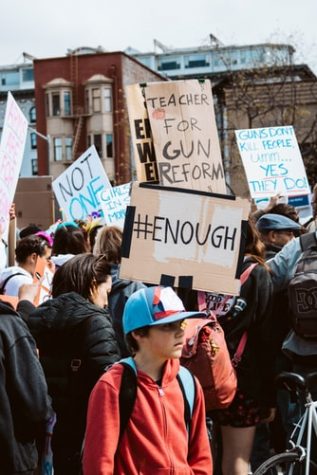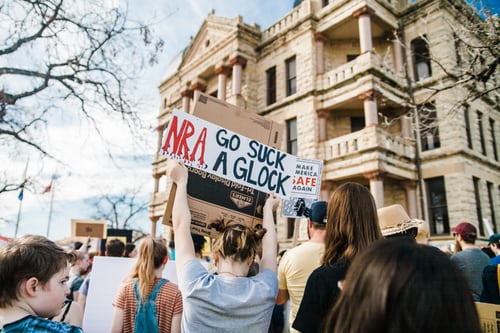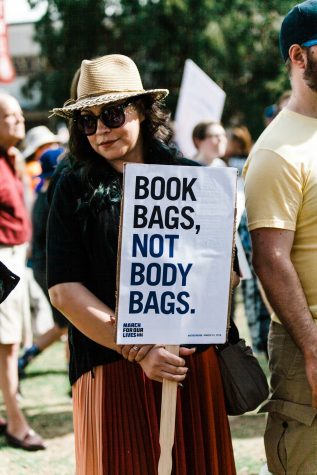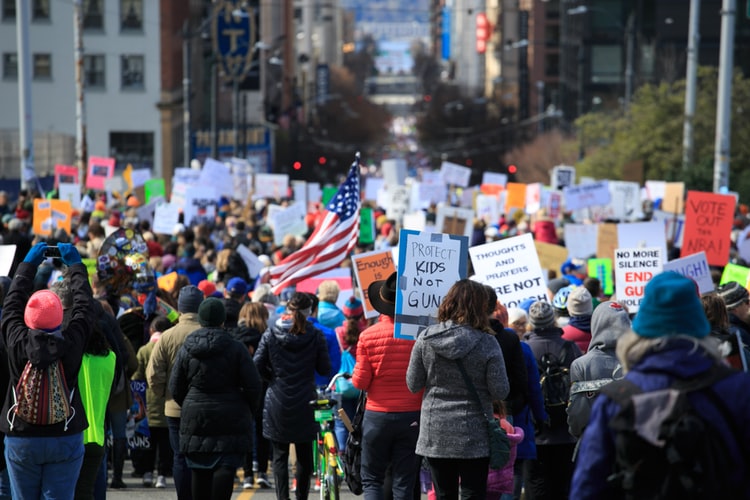Gipson: Gun violence is a problem nobody’s trying to solve
Gun violence kills far too many for inaction.
November 21, 2019
During my freshman year, I was almost a victim of gun violence. School shooting threats appeared on social media posts made by my peers, but they were frustratingly ignored by school administrators. We scuffled into school, aware of the increased police presence, a whole two extra school officers. Yet, none of us–staff and students alike–felt safe. Events like this were far too common in our country for us to not be on our toes. We feared that our lives would end in the place where we were supposed to develop our futures. Thankfully, there wasn’t an actual shooting that day, but not everyone has been that lucky.
Gun Violence in America
In 2019 alone, gun violence has taken the lives of 34,604 fathers, mothers, sons, daughters and friends, all within the great U.S. of A. Sadly, 100 Americans–100 of our own–are killed by firearms every single day. How many more slaughters will we witness before we stop sitting on our hands and take real steps towards getting to the core of the issue?
Our legislators have proven unwilling to step onto the side of saving lives, and we are the generation that is both being impacted the most and are left holding the ball to try to solve the problem. Our legislators are failing us.

People gather at the national March for Our Lives march.
On average, there are 36,383 gun deaths per year and 100,120 gun injuries in America. In fact, America ranks higher than almost any other wealthy nation in gun deaths and even some less developed nations. In the U.S., an average of 4.43 people per 100,000 suffered a violent gun death in 2017, while other wealthy countries such as Japan, Iceland and Romania boast mere rates of 0.04, 0.07 and 0.08, respectively. Why is it that America is one of the most developed countries in the world, yet our gun violence rate is 10 times that of most other developed nations? Our country lacks effective legislation to prevent these tragedies and nobody seems willing to put these in place, either.
The first aspect of our high rate of gun-inflicted deaths is suicide, which accounts for two-thirds of American gun deaths. In fact, the U.S. gun-suicide rate is 10 times that of other high-income countries. Gun access even triples the chance of committing suicide. Now, realistically, almost all gun suicide deaths are carried out with weapons that could be legally obtained, even with proper legislation.
However, this falls under a long, underlying cause of gun violence in America: our broken mental health system. While some may argue that the mental health system is not broken because it has never been whole, there is still the basic principle that our mental healthcare system is deeply flawed. In its current state, we have a system that focuses primarily on profit instead of helping people with serious mental conditions. Licensed “professionals” are quick to write out prescriptions or lock people away in asylums, but there is rarely a focus on rehabilitation. While increased free and affordable access to quality mental health care won’t completely get rid of the problem, it’s still a tremendous step in the right direction. Therefore, I personally believe if we take the shambles of this system and make it function as it should, we could significantly reduce our nation’s number of suicides and gun-related deaths.
The other third of gun violence in America is something we see all too much: homicide. As of now, the U.S. gun homicide rate is 25 times more than other high-income countries. In fact, gun accessibility doubles the risk of homicides. The main problem with gun violence in America is the large impact it has on children and teenagers. In the U.S., firearms are the second leading cause of death for children and teens, falling short behind motor vehicles. In 2016, about 3,143 children and teens below the age of 19 died from firearm-related deaths.

Heather Mount,Unsplash[Fair Use]
A marcher holds up a sign reading, “NRA go suck a glock.”
Government Failure
The problem with this, though, is that it’s mostly a uniquely American problem. Almost all adolescent firearm deaths, 90 percent, in developed countries occur in America.
Other countries suffer from one mass shooting, and they immediately change their legislation. After a mass shooting in New Zealand, their parliament voted 119-1 to change gun laws less than a month later. Yet, America has had 2,296 mass shootings, just since Sandy Hook in 2012. With this staggering number of tragedies, one would believe that we’d get the same legislature put into place to keep our citizens safe. Despite the need for gun control, all we get are “thoughts and prayers” from politicians. To be blunt, thoughts and prayers are getting us nowhere when policy and change is what we need and desire.
When you get down to the roots of the prevalence of mass shootings in America, a huge reason behind tragedy is the lack of strong gun laws. In a majority of states, private firearm sales without background checks are completely legal. This means that someone could sell a gun to a random person on Craigslist, without even getting a background check on the buyer. This is such a problematic practice, that a bill was proposed by the House of Representatives. The bill, H.R.8., would require background checks for all firearm sales, with a few exceptions to the law. In the midst of the Saugus High shooting this past week, Democratic senator Chris Murphy of Connecticut requested that the bill be passed by unanimous consent.
“We can’t go 24 hours without news of another mass shooting somewhere in America. My kids and millions’ others hide in corners of their classroom or in their bathrooms preparing for a mass shooting at their school, and this body does nothing about it,” Murphy said when presenting the bill to the Senate floor. The bill was inevitably blocked by the Republican-controlled Senate who, even right after a deadly mass shooting, don’t understand the positive effects of such a bill.
In fact, this whole scenario reinforced one fact of this epidemic: young people have to use their voices to fight against gun violence and a government that is doing nothing to help us. As Generation Lockdown, we have to open our eyes and realize that gun violence is destroying us. We need to fight for a safer America. We need to stand up to Congress and legislators who are doing nothing to help us. We, as young people, must recognize the power of our voices to push for better legislation.
The first step in this fight is recognition. We must recognize gun violence as it is: a national public health emergency. We must also recognize it in all of its forms: from rural suicides to intimate partner violence to urban youth violence to violence driven by white supremacist ideologies. We must recognize that it will take innovative, bold solutions to fix a problem that is so deeply rooted in American society.
Fighting for Change
In order to combat gun violence, many people, myself included, believe in a peace plan known as C.H.A.N.G.E. This consists of six bold steps that should be considered to address the national gun violence epidemic, put together by March for Our Lives. They created C.H.A.N.G.E. as a part of their “Peace Plan for a Safer America.”

A mother protests gun violence in schools.
The first step is to Change the standards of gun ownership. This means advocating for gun legislation which would raise the national standard for gun ownership-universal background checks and policies to disarm gun owners who pose a risk to themselves or others, such as people with dangerous mental illnesses.
The second step is to Halve the rate of gun deaths in 10 years. The government should mobilize an urgent and comprehensive federal response: declare a national emergency around gun violence and announce an audacious goal to reduce gun deaths by 50 percent in 10 years, saving 200,000 American lives as a result.
The third step would be Accountability. The government should hold gun lobby and industry accountable for misguided behavior meant to shield themselves and to fully repeal the Protection of Lawful Commerce in Arms Act, which stops gun companies who market their weapons to at-risk males from being held accountable for their actions.
The fourth step is to Name a Director of Gun Violence Prevention, who would operationalize federal goals in stopping gun violence and oversee gun violence prevention research. This position is well-needed because we have no government office committed to gun violence prevention, despite it being set to take the stage for the number one cause of death in teens.
The fifth step would be to Generate community-based solutions, such as mental health programs, suicide prevention programs, etc. This would be such an important implementation, especially with the importance of mental health in preventing future tragedies.
The final step is to Empower the next generation by doing things such as mailing voter registration cards to all US citizens when they turn 18. Empowering young people is one of the most important parts of the plan due to the fact that we are affected on great scales by gun violence, considering it is the second leading cause of death for adolescents. Not to mention that young people are the ones who will be running the government in the future, so it’s best to empower them and get them invested in politics at an early age.
While many may not agree with the C.H.A.N.G.E. plan, it still follows one basic principle: the government needs to figure out how to solve the gun violence epidemic. Too many American citizens have fallen prey to this wave of violence, and legislators should be passing bills to stop it.
To all the young people out there, do not think your voice does not matter. If you feel that gun violence has gone too long unchecked, then stand up and fight. 34,604. Let’s use our power and our voices to half that number in the near future. Only together can we inspire lawmakers to take a stand and pass gun-smart legislature.
Stand up to the NRA. Stand up to Congress. Break the stigma. Let’s stifle gun violence in America, together.

Tanya Voorhees • Nov 22, 2019 at 5:32 am
This is a brave stance to take in our very gun-centric Mississippi culture. Kudos to the author, David Gipson, for presenting his argument so eloquently. Kudos to the staff at The Vision for publishing and giving this piece a broader reach. And, likewise, kudos to MSMS for providing a fostering environment for critical thinking about such pertinent social issues.